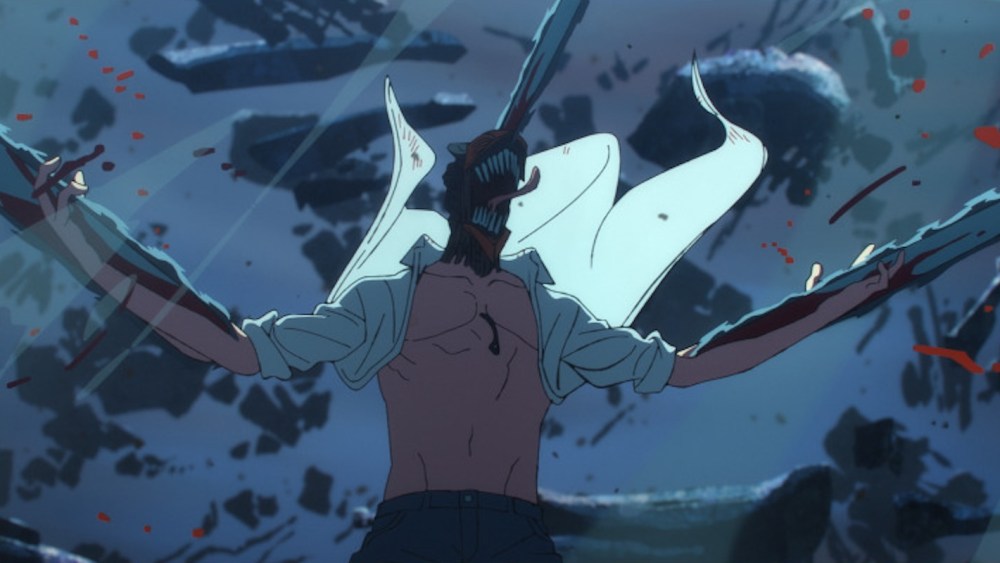There’s a motorized blade on his face and adolescent hormones coursing through his body, as he fights villainous entities bent on causing humans harm. Sixteen-year-old Denji (voiced by Kikunosuke Toya) has never attended school, but instead works as a Public Safety Devil Hunter (he is part demon, part human). Alongside the protagonists of “KPop Demon Hunters” and “Demon Slayer: Kimetsu no Yaiba Infinity Castle,” he joins the chorus of animated paladins facing off diabolical adversaries on the big screen this year.
But before “Chainsaw Man – The Movie: Reze Arc” ever shows him in his monstrous form, Denji’s teenage insecurities and romantic woes come to the foreground. From director Tatsuya Yoshihara, the first film spawned from the popular series, which is in turn based on the manga by Tatsuki Fujimoto, drops us into an already established universe — as movies based on anime shows tend to do.
Context clues might help those with minimal knowledge of “Chainsaw Man” gather that in this reality, demons with superhuman powers are a constant threat. Otherwise, it’s all mostly recognizable as identical to our world. Designed to satisfy existing fans, not so much to gain new acolytes, “Chainsaw Man” can still entertain because at its barest, the concept and plot don’t seem too intricate.
An awkward boy, Denji nervously agrees to go on a date with his boss, Makima (Tomori Kusunoki). Their rendezvous feels like an homage to cinema, as they spend an entire day hopping from one movie theater to another. She has strong opinions on the quality of the films, he’s concerned that nothing seems to move him. It’s only when watching an art-house film late at night that they both fully bask in the power of the medium. Up to this point, even if one has little information about these characters and their bond, “Chainsaw Man” plays like a teenage dramedy, and it remains that way for a third of its running time.
That Makima disappears for most of the remaining drama and chaos reiterates the film’s episodic quality. Likely, she’ll simply return in the next chapter on TV, thus her absence is not a cause for alarm. A central love triangle emerges, at least in Denji’s eager mind, when he meets Reze, a server at a local café. Her overt interest in him is enough for him to reciprocate. But she might not be who she says she is. Evocative animation, with subdued blue hues and soft lighting, conveys the flirtatiousness of their rapid connection in a scene where the two swim together in a pool at night. It’s also here that a few glimpses into Denji’s mind show sexually suggestive images of both Makima and Reze, as he struggles to decide whom to be faithful to, making it clear that a mature audience is the target.
When Reze is revealed as the extremely violent Bomb Devil, a hurt Denji realizes that she doesn’t want to gain his heart, but quite literally carve it out of his chest. The necklace she wears is the safety pin she can pull to detonate herself, just as Denji pulls the starter cord on his chest to become Chainsaw Man, both are clever character design details. “Chainsaw Man” sporadically checks in on a separate storyline with Aki (Shôgo Sakata), Denji’s coworker, and a halo-sporting Angel Devil (Maaya Uchida), offering even fewer details about the pair’s relevance, other than a shocking undercurrent of nihilism. As Reze’s violence escalates, all the “good guys” come together in a unified front against the malevolent Reze.
The corpses of deceased civilians litter the streets as blood pools — beheadings, dismemberments and bodies exploded into liquid flesh — while buildings and other structures collapse. This is a war zone. Fundraisers for the victims of devil attacks, apparently a common occurrence in this reality, acknowledge the death toll that these supernatural clashes leave behind. That’s more than one can say for the “Avengers” movies, where the destruction that results from the many confrontations is not dealt with.
A whirling semi-final showdown unfolds inside a sentient devil typhon and gives way to even more frantic editing as Denji in Chainsaw Man form rides his unwanted sidekick, an anthropomorphic shark, to defeat Reze. The action here moves at lightning speed with fiery explosions and relentless chaos taking over the screen via an impressive amalgamation of fluid character animation and high-octane effects. The second half of this epic scrimmage between good and evil feels like an unending sequence of increasingly deadly battles.
“Chainsaw Man” eventually lands on a more emotional resolution, proposing that the attraction between Denji and Reze was perhaps mutual (could a devil fall in love?), only to turn around and end on a gruesome note that delivers swift and brutal justice. For someone steeped in the characters and lore, watching anime films like this must yield the satisfaction of seeing familiar screen friends in a bigger adventure and canvas. For the uninitiated, however, it’s like catching up with a train that left the station a while ago, and that one may not be all that interested in boarding anyway.

